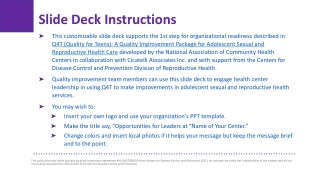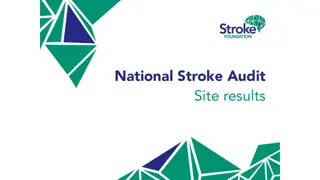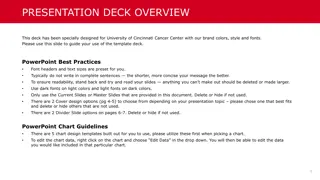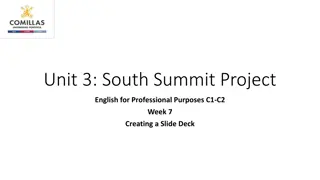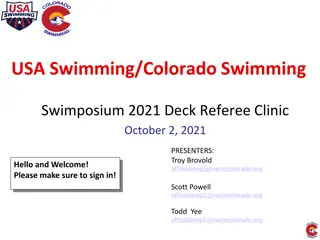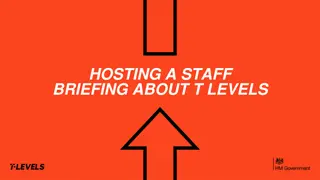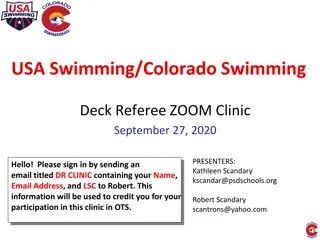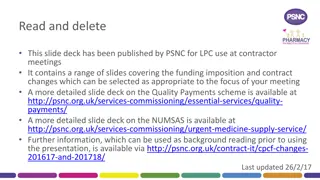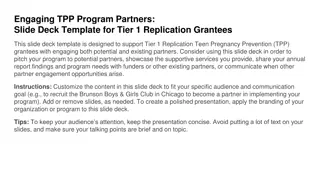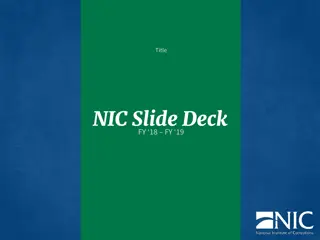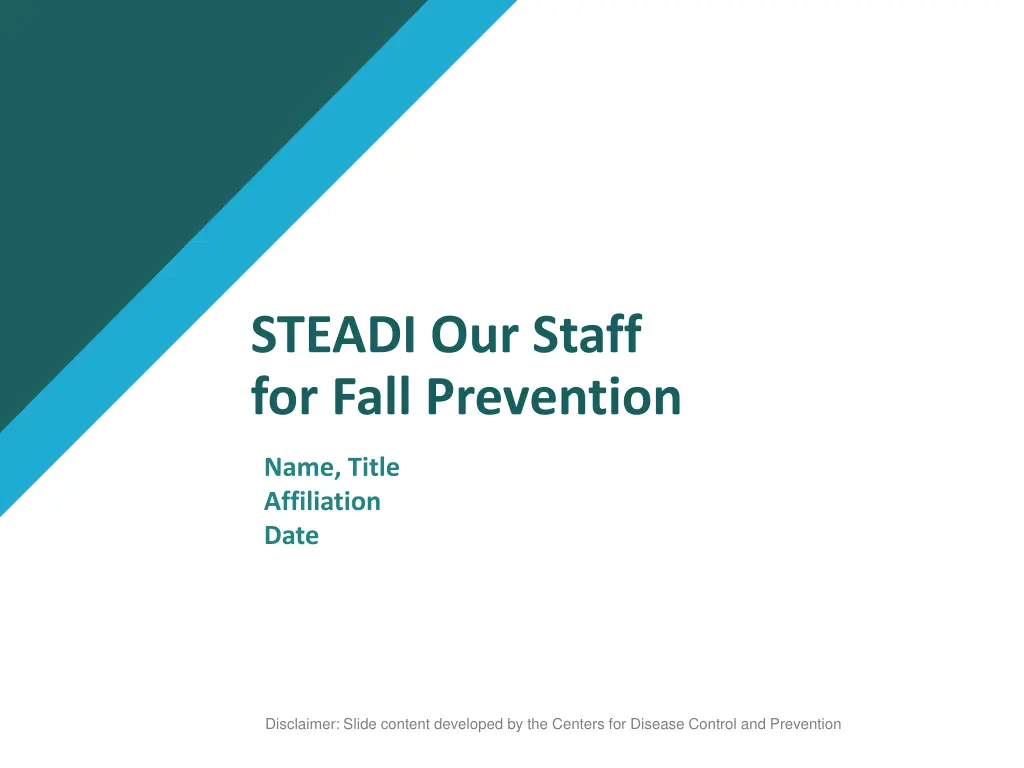
Preventing Falls: Strategies for Healthcare Staff Training
Train healthcare providers and clinic staff on fall prevention using the STEADI initiative. Highlight the burden of falls, risk factors, prevention strategies, and available resources. Encourage discussions on personal experiences with falls among older adults for better understanding and prevention.
Download Presentation

Please find below an Image/Link to download the presentation.
The content on the website is provided AS IS for your information and personal use only. It may not be sold, licensed, or shared on other websites without obtaining consent from the author. If you encounter any issues during the download, it is possible that the publisher has removed the file from their server.
You are allowed to download the files provided on this website for personal or commercial use, subject to the condition that they are used lawfully. All files are the property of their respective owners.
The content on the website is provided AS IS for your information and personal use only. It may not be sold, licensed, or shared on other websites without obtaining consent from the author.
E N D
Presentation Transcript
STEADI Our Staff for Fall Prevention Name, Title Affiliation Date Disclaimer: Slide content developed by the Centers for Disease Control and Prevention
How to Use These Slides Purpose: Train staff on using the STEADI initiative to prevent falls Target audience: Healthcare providers and clinic staff Slide order can be modified to fit your presentation Slides 4, 38, and 39 can be customized Some slide notes include suggested talking points Resource gallery showcases referenced STEADI resources References are listed at the end of presentation by slide number
Presentation Overview This presentation will highlight: The burden of falls Risk factors for falls How we can prevent falls Tips for implementing a fall prevention program Screening for fall risk Assessment of fall risk factors Effective strategies to reduce fall risk Follow-up with patients Available tools and resources
Your Thoughts and Experiences with Falls How have falls among older adults (age 65+) affected you? Have you or someone you know fallen? What kind of life-changing events occurred because of the fall? How could the fall have been prevented?
Leading Causes of Death Reference: (1)
Falls Are Common Data sources: National Vital Statistics System, National Electronic Injury Surveillance System All Injury Program, and Behavioral Risk Factor Surveillance System. References: (1,2)
Falls Might Not Be a Priority for Patients Less than half of older adults who fall talk to their doctor about falls Reasons patients do not talk to their doctor: o Belief that falls are a normal part of aging o Fear that a fall may lead to loss of independence o Not aware of common fall risk factors References: (3-5)
Falls Might Not Be a Priority for Patients Few older adults speak to someone about medications and fall risk Example: In the past 12 months, who has talked to you about medications that might make you fall?* *Percentage does not add up to 100 because participants could select more than one response option. Source: ConsumerStyles survey 2016 Reference: (5)
Falls Might Not Be a Priority for Providers Providers also face many barriers to addressing falls with older patients Competing healthcare priorities Lack of time during office visits Limited fall prevention knowledge Limited communication between providers from different disciplines Limited reimbursement strategies References: (6,7)
Consequences of Falls Among Older Adults More than 95% of hip fractures are due to falls Falls are the leading cause of traumatic brain injuries Falls and fall injuries increase the risk of nursing home placement Fall death rates increased about 30% between 2009 and 2018 References: (8-11)
Falls Are Costly Average hospitalization cost due to a fall injury is $30,000 o Fall-related injuries are a leading cause of hospital readmission Average cost per fall injury: o Emergency Department visits = $4,829 o Office-based and outpatient visits = $5,813 References: (12-14)
Falls Are Costly Florence C., et al. (2018). Medical costs of fatal and nonfatal falls in older adults. Journal of the American Geriatrics Society, 66(4), 693-698. Reference: (15)
Falls Are a Growing Burden Data sources: Behavioral Risk Factor Surveillance System and United States Census Bureau References: (2,16)
Common Fall Risk Factors Modifiable Risk Factors Non-modifiable Risk Factors Gait, strength, and balance deficits Medications that increase fall risk Home hazards Orthostatic hypotension Vision problems Foot issues/inappropriate footwear Vitamin D deficiency Comorbidities Age Sex Race/ethnicity History of falls Fall risk increases as the number of risk factors increases. v References: (2,17-19)
Falls Are Preventable The Stopping Elderly Accidents, Deaths, and Injuries (STEADI) initiative was developed by the U.S. Centers for Disease Control and Prevention (CDC) o STEADI is based on the American and British Geriatrics Societies Clinical Practice Guideline for Prevention of Falls in Older Persons and designed with input from healthcare providers o STEADI offers tools and resources to help healthcare providers Screen, Assess, and Intervene to reduce fall risk References: (20,21)
Overcoming Implementation Barriers Use existing incentives to screen and assess for fall risk o Welcome to Medicare Visit o Annual Medicare Wellness Visit Adapt STEADI tools to fit priorities and clinical workflow Reference: (22)
Successful Implementations Oregon Health & Science University, Oregon 64% of patients screened for fall risk At-risk patients with modifiable risk factors, such as gait impairment and orthostatic hypotension, received interventions United Health Services Hospitals, New York 79% of patients screened for fall risk At-risk patients with a fall prevention care plan were 40% less likely to have a fall-related hospitalization, compared to at-risk patients without a plan References: (23-25)
Benefits of a STEADI-based Fall Prevention Program Use STEADI to: Prevent fall-related hospitalizations Reduce healthcare costs Improve the lives and independence of older patients References: (25,26)
STEADI Algorithm STEADI Resource STEADI Algorithm: Algorithm for Fall Risk Screening, Assessment, and Intervention Reference: (27)
STEADI: Screening If your patient is 65 or older, screen o Once a year for fall risk or o If they present with an acute fall Two validated screening tools include o The Three Key Questions o CDC s Stay Independent questionnaire References: (20,24,28)
Screening Tool: The Three Key Questions Ask your patient these questions: o Have you fallen in the past year? o Do you feel unsteady when standing or walking? o Do you worry about falling? RESULTS Reference: (24)
Screening Tool: Stay Independent Questionnaire References: (28,29)
Screening Tool: Stay Independent Questionnaire RESULTS Score of 4 or more Interpretation: Screened at fall risk Next steps: Conduct fall risk assessment Score less than 4 and patient fell in the past year Interpretation: Screened at fall risk Next steps: Conduct fall risk assessment Score less than 4 Interpretation: Screened not at fall risk Next steps: Recommend strategies to prevent future fall risk References: (28,29)
Tips to Implement Fall Screening Integrate screening tools to fit your clinic workflow o Example: Add to usual patient intake forms Find an optimal time to ask screening questions o Before an office visit by phone or online portal o During routine office visit in the waiting room or the exam room o During Welcome to Medicare Examination or Medicare Annual Wellness Visit Set screening goals and monitor progress o Example: Goal: We will screen 50% of our older adult patients in 30 days Monitor: Percent of older patients screened for fall risk in the past 30 days Share progress with team members Reference: (22)
STEADI: Assessment To identify modifiable fall risk factors in at-risk patients: Conduct a falls history. Example questions: o How many times have you fallen? o Did you have any symptoms prior to your fall? o Where and when did you fall? References: (20,27)
STEADI: Assessment To identify modifiable fall risk factors in at-risk patients: Conduct assessments: o Evaluate gait, strength, and balance o Identify medications that increase fall risk o Ask about potential home hazards o Measure orthostatic blood pressure o Check visual acuity o Assess feet and footwear o Assess vitamin D intake o Identify comorbidities References: (20,27)
STEADI: Intervention Reference: (27)
Components of STEADI: Examples Intervention Fall Risk Factor Assessment Physical therapy Evidence-based fall prevention program Conduct tests: - Timed Up and Go (TUG) - 30-second chair stand - 4-stage balance Gait, strength, and balance deficits STEADI Resource Handouts: TUG, 30-second chair stand, and 4-stage balance tests Instructional videos: TUG, 30-second chair stand, and 4 stage balance tests References: (20,22)
Components of STEADI: Examples Intervention Fall Risk Factor Assessment Medication management - Stop medications when possible - Switch to safer alternatives - Reduce to lowest effective dose Conduct a comprehensive medication review Medications that increase fall risk STEADI Resource Fact sheets: Medications Linked to Falls, SAFE Medication Review Framework, STEADI-Rx Pharmacist Flyer References: (20,22)
Components of STEADI: Examples Intervention Fall Risk Factor Assessment Refer to occupational therapy Recommend tips to improve home safety Ask patients and their family members about home safety Home hazards STEADI Resource Educational material: Check for Safety References: (20,22)
Components of STEADI: Examples Intervention Fall Risk Factor Assessment Measure orthostatic blood pressure 1. Have the patient lie down for 5 minutes 2. Check blood pressure 3. Have the patient stand 4. Check blood pressure within 3 minutes Orthostatic hypotension The patient has orthostatic hypotension if systolic blood pressure drops by at least 20 mm Hg or diastolic by at least 10 mm Hg Treat underlying cause Adjust medications if warranted STEADI Resource Handout: Measuring Orthostatic Blood Pressure Educational material: Postural Hypotension References: (20,22)
Components of STEADI: Examples Intervention Fall Risk Factor Assessment Ask patients about vision problems Use Snellen eye chart to assess visual acuity Ask if patient uses bifocal lenses when outdoors Refer to ophthalmology or optometry Recommend single distance lenses for walking outside Vision impairment STEADI Resource Guide: Coordinated Care Plan to Prevent Older Adult Falls Educational materials: Family Caregivers: Protect your Loved Ones from Falling, What You Can Do to Prevent Falls References: (20,22)
Components of STEADI: Examples Intervention Fall Risk Factor Assessment Look for foot deformities, deficits in sensation, or pain Assess for inappropriate footwear Counsel on shoe fit, insoles, and heel height Refer to podiatry Feet or footwear issues STEADI Resource Guide: Coordinated Care Plan to Prevent Older Adult Falls Educational materials: Family Caregivers: Protect your Loved Ones from Falling, What You Can Do to Prevent Falls References: (20,22)
Components of STEADI: Examples Intervention Fall Risk Factor Assessment Consider increasing dietary vitamin D or daily vitamin D supplements if the patient has a vitamin D deficiency Ask about patient s dietary vitamin D intake, use of vitamin D supplements, and sun exposure Vitamin D deficiency STEADI Resource Guide: Coordinated Care Plan to Prevent Older Adult Falls Educational materials: Family Caregivers: Protect your Loved Ones from Falling, What You Can Do to Prevent Falls References: (20,22)
Components of STEADI: Examples Intervention Fall Risk Factor Assessment Screen for comorbidities such as osteoporosis, depression, dementia, incontinence Optimize treatments of identified conditions Comorbidities STEADI Resource Guide: Coordinated Care Plan to Prevent Older Adult Falls Educational materials: Family Caregivers: Protect your Loved Ones from Falling, What You Can Do to Prevent Falls References: (20,22)
Follow-Up Follow up with patients within 30 90 days Review plan of care Encourage adherence to recommendations Discuss barriers to adherence STEADI Resource Fact sheet: Talking with Patients about Fall Prevention Educational materials: Family Caregivers: Protect your Loved Ones from Falling References: (20,22)
Tips to Implement Fall Assessment & Intervention Divide tasks among clinic staff, including follow-up Pilot the fall prevention program before expanding Seek feedback from staff on progress and barriers Provide refresher training at regular intervals Engage patient and caregivers STEADI Resource Wall chart: Practice Fall Prevention Wall Chart Reference: (22)
Our Fall Prevention Program Which fall risk factors will we focus on? How will our clinic workflow adapt STEADI s screen, assess, and intervene steps? How will the electronic health record incorporate fall prevention? How will the practice bill for fall prevention? How will the practice monitor and evaluate the program? Describe how members of the practice can play a role in fall prevention. STEADI Resource Guides: Coordinated Care Plan to Prevent Older Adult Falls, STEADI: Evaluation Guide for Older Adult Clinical Fall Prevention Programs References: (22,30)
Team and Roles Every member can play an important role in fall prevention Our team will include o Front office staff o Office manager o Medical assistants o Care coordinator o Nurses o Physician, physician assistants, or nurse practitioners o Pharmacists o Physical therapists o Occupational therapists
Lets Do Our Part to Prevent Falls Learn about older adult fall prevention and STEADI resources o Available at www.cdc.gov/steadi Earn continuing education with an online training on fall prevention o STEADI: Empowering Healthcare Providers to Reduce Fall Risk Available at www.cdc.gov/steadi/training.html Hear from other healthcare providers on their STEADI experience o Available at www.cdc.gov/steadi/about/success-stories.html
Appendix: Resource Gallery STEADI Guides Evaluation Guide for Older Adult Clinical Fall Prevention Programs Coordinated Care Plan to Prevent Older Adult Falls
Appendix: Resource Gallery STEADI Assessment Handouts Timed Up & Go (TUG) 4-Stage Balance 30-Second Chair Stand Measuring Orthostatic Blood Pressure
Appendix: Resource Gallery STEADI Fact Sheets Medications Linked to Falls SAFE Medication Review Framework STEADI-Rx Pharmacist Flyer Talking about Fall Prevention with Your Patients
Appendix: Resource Gallery STEADI Educational Materials
Appendix: Resource Gallery Wall Chart and Algorithm Algorithm for Fall Risk Screening, Assessment, and Intervention (front page) Practice Fall Prevention Wall Chart
References Slide 5 1. CDC. Web-based Injury Statistics Query and Reporting System (WISQARS) [online]. [cited 2021 January 19]. Available from URL: www.cdc.gov/injury/wisqars. Atlanta, GA: National Center for Injury Prevention and Control. Slide 6 1. CDC. Web-based Injury Statistics Query and Reporting System (WISQARS) [online]. [cited 2021 January 19]. Available from URL: www.cdc.gov/injury/wisqars. Atlanta, GA: National Center for Injury Prevention and Control. Moreland B, Kakara R, Henry A. Trends in Nonfatal Falls and Fall-Related Injuries Among Adults Aged 65 years United States, 2012-2018. MMWR Morb Mortal Wkly Rep 2020;69(27):875-881. DOI: 10.15585/mmwr.mm6927a5 2.
References Slide 7 3. Stevens JA, Ballesteros MF, Mack KA, Rudd RA, DeCaro E, Adler G. Gender Differences in Seeking Care for Falls in the Aged Medicare Population. Am J Prev Med 2012;43(1):59-62. DOI: 10.1016/j.amepre.2012.03.008 Stevens JA, Noonan RK, Rubenstein LZ. Older Adult Fall Prevention: Perceptions, Beliefs and Behaviors. Am J Lifestyle Med 2010;1:16-20. DOI: 10.1177/1559827609348350 Haddad YK, Karani MV, Bergen G, Marcum ZA. Willingness to Change Medications Linked to Increased Fall Risk: A Comparison between Age Groups. J Am Geriatr Soc 2019;67(3):527-533. DOI: 10.1111/jgs.15696 4. 5. Slide 8 5. Haddad YK, Karani MV, Bergen G, Marcum ZA. Willingness to Change Medications Linked to Increased Fall Risk: A Comparison between Age Groups. J Am Geriatr Soc 2019;67(3):527-533. DOI: 10.1111/jgs.15696 Slide 9 6. Jones TS, Ghosh TS, Horn K, Smith J, Vogt RL. Primary Care Physicians Perceptions and Practices Regarding Fall Prevention in Adults 65 Years and Over. Accid Anal Prev 2011;43:1605-1609. DOI: 10.1016/j.aap.2011.03.013 Van Rhyn B, Barwick A. Health Practitioners Perceptions of Falls and Fall Prevention in Older People: A Metasynthesis. Qual Health Res 2019;29(1):69-79. DOI: 10.1177/1049732318805753 7.
References Slide 10 8. Parkkari J, Kannus P, Palvanen M, Natri A, Vainio J, Aho H, et al. Majority of Hip Fractures Occur as a Result of a Fall and Impact on the Greater Trochanter of the Femur: A Prospective Controlled Hip Fracture Study with 206 Consecutive Patients. Calcif Tissue Int 1999;65(3):183-7. DOI: 10.1007/s002239900679 Taylor CA, Bell JM, Breiding MJ, Xu L. Traumatic Brain Injury Related Emergency Department Visits, Hospitalizations, and Deaths United States, 2007 and 2013. MMWR Surveill Summ 2017;66(No. SS-9):1 16. DOI: 10.15585/mmwr.ss6609a1 10. Gill TM, Murphy TE, Gahbauer EA, Allore HG. Association of Injurious Falls With Disability Outcomes and Nursing Home Admissions in Community-Living Older Persons. Am J Epidemiol 2013;178(3):418 25. DOI: 10.1093/aje/kws554 11. CDC. Wide-ranging OnLine Data for Epidemiologic Research (WONDER) [online]. [cited 2021 January 19]. Available from URL: https://wonder.cdc.gov. Atlanta, GA: Centers for Disease Control and Prevention. 9.
References Slide 11 12. Burns ER, Stevens JA, Lee R. The Direct Costs of Fatal and Non-fatal Falls Among Older adults United States. J Safety Res 2016;58:99-103. DOI: 10.1016/j.jsr.2016.05.001 13. Bohl AA, Fishman PA, Ciol MA, Williams B, Logerfo J, Phelan EA. A Longitudinal Analysis of Total 3-Year Healthcare Costs for Older Adults Who Experience a Fall Requiring Medical Care. J Am Geriatr Soc 2010;58(5):853-60. DOI: 10.1111/j.1532-5415.2010.02816.x 14. Hoffman GJ, Liu H, Alexander NB, Tinetti M, Braun TM, Min LC. Posthospital Fall Injuries and 30-Day Readmissions in Adults 65 Years and Older. JAMA Netw Open 2019;2(5):e194276. DOI: 10.1001/jamanetworkopen.2019.4276 Slide 12 15. Florence CS, Bergen G, Atherly A, Burns E, Stevens J, Drake C. Medical Costs of Fatal and Nonfatal Falls in Older Adults. J Am Geriatr Soc 2018;66(4):693-8. DOI: 10.1111/jgs.15304 Slide 13 2. Moreland B, Kakara R, Henry A. Trends in Nonfatal Falls and Fall-Related Injuries Among Adults Aged 65 years United States, 2012-2018. MMWR Morb Mortal Wkly Rep 2020;69(27):875-881. DOI: 10.15585/mmwr.mm6927a5 16. Ortman JM, Velkoff VA, Hogan H. An Aging Nation: The Older Population in the United States, Current Population Reports, P25-1140. Washington, DC: U.S. Census Bureau. 2014.
References Slide 14 2. Moreland B, Kakara R, Henry A. Trends in Nonfatal Falls and Fall-Related Injuries Among Adults Aged 65 years United States, 2012-2018. MMWR Morb Mortal Wkly Rep 2020;69(27):875-881. DOI: 10.15585/mmwr.mm6927a5 17. Ambrose AE, Paul G, Haudorff JM. Risk Factors for Falls Among Older Adults: A Review of the Literature. Maturitas 2013;75:51-61. DOI: 10.1016/j.maturitas.2013.02.009 18. Tinetti ME, Speechley M, Ginter SF. Risk Factors for Falls Among Elderly Persons Living in the Community. New Engl J Med 1988;319(26):1701 7. DOI: 10.1056/NEJM198812293192604 19. Burns E, Kakara R. Deaths from Falls Among Persons Aged 65 Years United States, 2007 2016. MMWR Morb Mortal Wkly Rep 2018;67:509-514. DOI: 10.15585/mmwr.mm6718a1 Slide 15 20. AGS/BGS. Summary of the Updated American Geriatrics Society/British Geriatrics Society Clinical Practice Guideline for Prevention of Falls in Older Persons. J Am Geriatr Soc 2011;59(1):148 57. DOI: 10.1111/j.1532- 5415.2010.03234.x 21. Lee R. The CDC s STEADI Initiative: Promoting Older Adult Health and Independence Through Fall Prevention. Am Fam Physician 2017;96(4):220 1. Slide 16 22. Eckstrom E, Parker EM, Shakya I, Lee R. Coordinated Care Plan to Prevent Older Adult Falls. Atlanta, GA: National Center for Injury Prevention and Control, Centers for Disease Control and Prevention. 2021. Available at: https://www.cdc.gov/steadi/pdf/Steadi-Coordinated-Care-Plan.pdf

